|
|
More Gambling Tutorials |
- Introduction
- The Dice
- The Come-Out Roll & the Pass Line
- The Come-Out Roll & the Don't Pass Line
- Improving Your Chances by Taking the Odds
- True Odds Pay-Offs
- Betting Even Amounts
- The Don't Pass Line Odds
- Come Bets
- Come Bet Odds
- Don't Come Bet Box
- Don't Come Bet Odds
- Place Bets
- Buy Bets
- Lay Bets
- Proposition Bets (One Roll Bets)
- Proposition Bets (Hardways)
- Big 6 & 8
- Field Bets
- Odds Charts
|
|
|
|
Also known as “Dice”, Craps is one of the most exciting and fast paced games in the casino. It is not for the faint of heart.
To learn to play the game well requires lots of practice. Reading this tutorial will help, but the only way to really learn is to watch an actual game in play, or to participate, and to ask questions when in doubt about some of the finer points. But please wait until the table is “quiet” before you ask the dealer too many questions! He can get really busy!
Hundreds, if not thousands of dollars, are won or lost in the blink of an eye. Roll up your sleeves. Prepare to join the battle. When armed with both knowledge and play time, the player soon discovers that the edge for the house is lower than for any other table game in the casino.
The table itself has room for many players. The layout on one end is replicated by the layout on the other end for easier access by all.
There are many, many ways to make a bet on a craps table. We will review most of them here.
Remember to never actually hand the dealer any money you intend to bet. Place the money on the table in front of you. The dealer will pick it up and follow any of your requests. This is longstanding casino etiquette. |
| Back to Top |
|
|
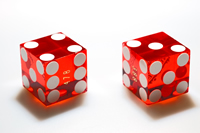 The “7” can be either good or
The “7” can be either good or
bad depending on when in the game
it is rolledThe goal of the shooter is to roll the right numbers at the right time. The players at the table make bets that reflect their “faith” in the dice and the shooter’s “skill.” |
| Back to Top |
|
|
Every new game begins with the “come-out” roll. Many of the bets on the table are not allowed until after the “come-out” roll. Just before the “come-out” roll, players typically make a bet on the “Pass Line” or “Don’t Pass Line”.
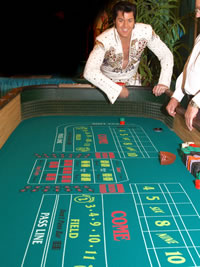 Elvis starts a new game!
Elvis starts a new game!Most players at the table usually begin with the “pass line” for it serves as the gateway to a new game about to be established.
For the sake of our discussion, let’s start with a player who bets $100 on the “pass line”. He places his bet on the “pass line” directly in front of him. Other players at the table may do the same thing, place bets directly in front of them on the “pass line”.
The shooter shoots the dice. A number comes up.
If a “7” or “11” is rolled, the “pass line” players automatically win even money on their bet. That $100 bet is now worth $200. Let it ride, or remove some or all of your money or just walk away.
If a “2” or “3 or “12” is rolled, you have “crapped” out and you lose. The dealer takes your money.
If any other number is rolled, such as a “4”, “5”, “6”, “8”, “9” or “10”, a “point” has now been established for the entire table and the shooter continues to shoot until he rolls the “point” again, or the “7”, which ever happens first.
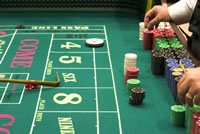 The "Point" is "4
The "Point" is "4The established “point” is marked by a white “puck” that says, “on”.
If the shooter matches the established “point” with the roll of the dice, every player who made a bet on the “pass line” is paid even money. If a “7” is rolled, all “pass line” players lose. The “stickman” at the table says, “7-out.” |
| Back to Top |
|
|
Some players prefer to play the “Don’t pass Line.” They place their bets here and whatever happens is the inverse or opposite of everything described above.
If a “7” or “11” is rolled, the “don’t pass line” players automatically lose their bets.
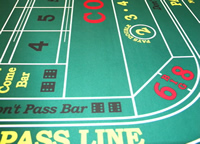 The Don't Pass Line/Bar
The Don't Pass Line/BarIf a “2” or “3” or is rolled, these players win. A “12” is a “push” and no one wins.
If any other number is rolled, such as a “4”, “5”, “6”, “8”, “9” or “10”, a “point” has now been established for the entire table that you are trying to beat.
If the “7” appears before any of these “points”, you win.
|
| Back to Top |
|
|
A player must “take the odds” whenever possible if he is to have any legitimate chance of winning real money over an extended period.
Important as a betting opportunity as it is, there are no signposts on a table that show you when and how to do this.
But the opportunity exists.
When you win your “pass line” bet, you are paid even money. This is not a fair payoff.
As you can see in the “Odds Chart”, there are 36 different ways to roll a number on the dice.
There are 6 ways to roll a “7”. There are 5 ways to roll a “6” or an “8”. This means that the odds are 6 to 5 against you that a “6” or an “8” will be rolled before a “7”.
When you win a “pass line” bet, the house pays you even money. You should be paid 6 to 5. If you bet $100, you should receive $120 back. But you don’t.
The house will pay you better than even money under the following conditions:
After the “come-out” roll and after the “point” has been made, the player may make an additional bet behind the “pass line”. This is called, “taking the odds”.
If your bet is $100 on the “pass line”, you may make a bet equivalent to that behind the “pass line”. Here are some notable exceptions. Many casinos offer something called, “double” or “triple” odds. Or, something called, 3x, 4x or 5x odds. Or, sometimes, even 100x odds. This means that you are allowed to bet more money than the $100 of your original “pass line” bet via the odds.
If your “pass line” bet is $100, you may make a bet of $100, $200 or more behind the “pass line”, depending on the rules of the house. If the “point” of “6”, for example, is rolled again by the shooter, you would be paid even money on the “pass line”, but a true payoff of 6 to 5 on the odds bet. (See “Odds Chart”).
When the house offers 3x, 4x, 5x odds, typically the house is saying that on “points” of 4 and 10 only, you may take an additional “odds bet” of $300 behind the “pass line”, if your original “pass line” bet is $100. If the “point” is “5” or “9”, you make take an “odds bet” of $400. If the “point” is “6” or “8”, you make take an “odds bet” of $500.
The best rule of thumb to consider when playing the “pass line” is to bet as little as possible on the “pass line” relative to the largest amount possible when “taking the odds”. |
| Back to Top |
|
|
| Here are the true odds for winning on the established “points”: |
4 and 10 (pays 2 to 1)
5 and 9 (pays 3 to 2)
6 and 8 (pays 6 to 5) |
| Back to Top |
|
|
You can see above what the true odds are when “taking the odds”. But just remember one thing: The house does not like to make small change. It is a casino, not a coin changer.
Therefore, when “taking the odds”, bet an amount that can be divisible for a clean payoff amount should you happen to win. For example, if you take odds on “6” with an amount of say $107, because you want to bet the last $107 in your pocket, how is the house going to pay you off at odds of 6 to 5? $107 is not cleanly divisible by 5, so you really should drop your odds bet to $100, for a clean payoff of $120, should you happen to win. Online casinos can instantly make the proper calculation, regardless of the bet amount, but dealers at real casinos have better things to do. |
| Back to Top |
|
|
Once again, if you are playing the “Don’t Pass Line”, you can now “lay” the odds that the “point” won’t be made before the “7” is made. Chances are the “7” will appear before anything else, so the true odds reflect that.
Here are the true odds for betting against the established “points”: |
4 and 10 (pays 1 to 2)
5 and 9 (pays 2 to 3)
6 and 8 (pays 5 to 6) |
| Back to Top |
|
|
After the “point” has been established for the table, any player may make a “come” bet. This area on the table is quite prominent and clearly marked.
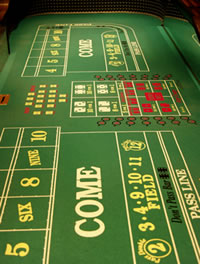 The Come Line both sides of the table
The Come Line both sides of the tableThe rules for the “come” bet are the same as for the “pass line.” But unlike the “pass line”, this area is reserved for players only after the “point” has been established for the entire table on the “come-out” roll.
It gets confusing. The “come-out roll” is the first roll of a new game, whereas the “come” bet is reserved for players only after the “point” has been established on the “come-out” roll. Got it?
Place your bet on the “come” before the shooter shoots the dice for the next round, and like the “pass line”, “7” or “11” pays even money and “2”, “3” or “12” is “craps” and you lose.
But here is the fun of making “come” bets: If a number is rolled other than “2”, “3”, “12”, “7” or “11”, that is, “4”, “5”, “6”, “8”, “9” or “10”, your own personal “point” has now been established and you have created a “game within a game.”
If you made a “pass line” bet at the beginning of a new game and a “point” was established for the entire table, and now you’ve made a “come” bet that has led to another “point” being established, you’ve got yourself more “points” to manage.
The dealer has moved your “come” bet over to the number that represents the “point” you have established for yourself. The dealer places your money on or near the number in a way that corresponds to your physical position at the table. This way, the dealer knows what money belongs to whom. |
| Back to Top |
|
|
| “Come” bet odds are the same as “taking the odds” behind the “pass line”. You are allowed to “take the odds” on the “point” you have now established for yourself via the “come” area. The same true odds apply, except that the dealer will handle your money on your behalf. If the “point” is “5”, you place the appropriate amount of money onto the table in front of you and tell the dealer, “odds on the “5” please.” he will follow your request. He places the chips on the edge of the original stack of your “come” bet that he has now moved over to the appropriate location. |
| Back to Top |
|
|
Some players prefer to play the “Don’t Come” box. They place their bets here and what happens is the inverse or opposite of everything described on the come line.
If a “7” or “11” is rolled, “the don’t come” box players automatically lose their bets.
If a “2” or “3” is rolled, these players win. A “12” is a “push” and no one wins.
If any other number is rolled, such as a “4”, “5”, “6”, “8”, “9” or “10”, a “point” has now been established that you are trying to beat.
If the “7” appears before any of these “points”, you win. |
| Back to Top |
|
|
Once again, if you are playing the “Don’t Come” box, you can now “lay” the odds that your “point” won’t be made before the “7” is made. Chances are the “7” will appear before anything else, so the true odds reflect that.
Here are the true odds for betting against these “points”: |
4 and 10 (pays 1 to 2)
5 and 9 (pays 2 to 3)
6 and 8 (pays 5 to 6) |
| Back to Top |
|
|
 Players may “place”
Players may “place”
the “4”, “5”, “6”, “8”, “9”, “10”“Place bets” allow the player to “take odds” without having to first make a bet at the “pass line” or “come line” box. “Place bet” odds can be taken any time after the “come-out” roll and can be removed by the player at any time. If “place bets” carry over from the previous round, the bets are not active until the new “point” is established.
However, there is a price to pay for all this convenience. The player is not paid “true odds” but the following special “place bet” odds: |
4 and 10 (pays 9 to 5. True odds: 2 to 1.)
5 and 9 (pays 7 to 5. True odds: 3 to 2.)
6 and 8 (pays 7 to 6. True odds: 2 to 1.) |
“Place bets” are lost when a “7” is rolled.
“Place bets” must be played in amounts that are easily divisible by the amount potentially to be won. For example, if you make a “place bet” on the “8”, whose place bet odds are 7 to 6, an amount should be bet that is divisible by 6 so that the payoff will result in an even amount. So, if you bet $12 on the “8” a winning profit would be an even $14.
Online casinos can instantly make the proper calculation, regardless of the bet amount, but dealers at real casinos have better things to do. |
| Back to Top |
|
|
A player may “buy” numbers rather than “placing” numbers. The numbers that may be bought are, once again, the “4”, “5”, “6”, “8”, “9” and “10”.
Any winning payoff is based on true odds: |
4 and 10 (pays 2 to 1)
5 and 9 (pays 3 to 2)
6 and 8 (pays 6 to 5) |
This time, however, the player must pay to the house a commission, or “vigorish” or “vig” of 5% of your bet, which is either paid when the bet is made or taken from any winnings.
Since the 5% commission is the same regardless of which number you “buy”, the commission would be less expensive if the 4 or 10 are rolled since the winning payoff is higher. |
| Back to Top |
|
|
“Lay” bets are the inverse or opposite of buy bets in that you are now betting that the “7” will be rolled before any specific number. In this case, you are not “taking the odds”, or “buying the odds”, but “laying the odds”.
Any winning payoff is based on true odds: |
4 and 10 (pays 1 to 2)
5 and 9 (pays 2 to 3)
6 and 8 (pays 5 to 6) |
| The player must also pay to the house a commission, or “vigorish” or “vig” of 5% of your bet, which is either paid when the bet is made or taken from any winnings. |
| Back to Top |
|
|
These bets can be made at any time during the game, even before the “come-out” roll and are good for one roll of the dice only.
A player can find these proposition bets in the center of the table. |
Any Seven “7” (Pays 4 to 1. True odds: 5 to 1.)
Any “2” or “12” (Pays 30 to 1. True odds: 35 to 1.)
Any “3” or “11” (Pays 15 to 1. True odds: 17 to 1.)
Horn Bet “2, 3, 11, 12” (All 4 numbers covered. Minimum bet required.)
Any Craps “2, 3 or 12” (Pays 7 to 1. True odds: 8 to 1.) |
| Back to Top |
|
|
| These bets remain good until a “7” is rolled or until a “soft” version of the same number is rolled. (For example, a hard “4” is a 2+2. A soft “4” is a 1+3 or 3+1.) |
Hard “4” and “10” (Pays 7 to 1. True odds: 8 to 1.)
Hard “6” and “8” (Pays 9 to 1. True odds: 10 to 1.) |
| Back to Top |
|
|
 “Big 6 & 8” lower right corner
“Big 6 & 8” lower right corner |
| Back to Top |
|
|
|
The “Field” bet is a one dice roll only that on its surface looks like a great bet but closer review shows otherwise. After all, if any one of these many numbers in the field are rolled before the “7”, you win even money: “3”, “4”, “9”, “10”, and “11.
If the “2” or “12” is rolled, you are paid 2 to 1. Some casinos pay 3 to 1 if the “12” is rolled. But since there are 36 different combinations on the dice and these numbers account for only 16 combinations, the odds are against you. |
| Back to Top |
|
|

| PASS LINE/COME LINE |
EVEN MONEY |
1.41% |
| SINGLE ODDS (1X) |
EVEN MONEY + ODDS |
0.85% |
| DOUBLE ODDS (2X) |
EVEN MONEY + ODDS |
0.61% |
| TRIPLE ODDS (3X) |
EVEN MONEY + ODDS |
0.47% |
| 3x4x5x (3X ON THE 4 AND 10, 4X ON THE 5 AND 9, 3X ON THE 6 AND 8) |
EVEN MONEY + ODDS |
0.37% |
| FIVE TIMES ODDS (5X) |
EVEN MONEY + ODDS |
0.33% |
| TEN TIMES ODDS (10X) |
EVEN MONEY + ODDS |
0.18% |
| HUNDRED TIMES ODDS (100X) |
EVEN MONEY + ODDS |
0.021% |
| DON’T PASS/DON’T COME |
EVEN MONEY |
1.40% |
| SINGLE ODDS (1X) |
EVEN MONEY + ODDS |
0.68% |
| DOUBLE ODDS (2X) |
EVEN MONEY + ODDS |
0.46% |
| 3x4x5x (3X ON THE 4 AND 10, 4X ON THE 5 AND 9, 3X ON THE 6 AND 8) |
EVEN MONEY + ODDS |
0.27% |
| TRIPLE ODDS (3X) |
EVEN MONEY + ODDS |
0.47% |
| FIVE TIMES ODDS (5X) |
EVEN MONEY + ODDS |
0.28% |
| TEN TIMES ODDS (10X) |
EVEN MONEY + ODDS |
0.12% |
| HUNDRED TIMES ODDS (100X) |
EVEN MONEY + ODDS |
0.014% |
|
|

| NUMBER |
BEFORE A "7" |
AFTER A "7" |
| 4 |
2 TO 1 |
1 TO 2 |
| 5 |
3 TO 2 |
2 TO 3 |
| 6 |
6 TO 5 |
5 TO 6 |
| 8 |
6 TO 5 |
5 TO 6 |
| 9 |
3 TO 2 |
2 TO 3 |
| 10 |
2 TO 1 |
1 TO 2 |
|
|

| PLACE THE 4 OR 10 |
9 TO 5 |
6.67% |
| PLACE THE 5 OR 9 |
7 TO 5 |
4.00% |
| PLACE THE 6 OR 8 |
7 TO 6 |
1.52% |
| BUY THE 4 OR 10 |
2 TO 1 (MINUS 5%) |
4.76% |
| BUY THE 5 OR 9 |
3 TO 2 (MINUS 5%) |
4.76% |
| BUY THE 6 OR 8 |
6 TO 5 (MINUS 5%) |
4.76% |
| LAY THE 4 OR 10 |
1 TO 2 (MINUS 5%) |
2.44% |
| LAY THE 5 OR 9 |
2 TO 1 (MINUS 5%) |
3.23% |
| LAY THE 6 OR 8 |
5 TO 6 (MINUS 5%) |
4.00% |
|
|

| BIG 6 OR BIG 8 |
EVEN MONEY |
9.09% |
THE FIELD– ONE ROLL BET |
| (WITH 2 AND 12 PAYING DOUBLE) |
EVEN MONEY ALL NUMBERS EXCEPT 2 AND 12 PAY 2 TO 1 |
5.55% |
| (WITH 12 PAYING TRIPLE) |
EVEN MONEY ALL NUMBERS EXCEPT 2 PAYS 2 TO 1 AND 12 PAY 3 TO 1 |
2.78% |
|
|

| BET |
TRUE ODDS |
PAYOFF |
HOUSE EDGE |
| HARDWAYS 4 OR 10 |
8 TO 1 |
7 TO 1 |
11.1% |
| HARDWAYS 6 OR 8 |
10 to 1 |
9 TO 1 |
9.09% |
ONE ROLL BETS |
| ANY SEVEN |
5 TO 1 |
4 TO 1 |
16.67% |
| ANY CRAPS |
8 TO 1 |
7 TO 1 |
11.1% |
| 2 OR 12 |
35 TO 1 |
30 TO 1 |
13.89% |
| 3 OR 11 |
17 TO 1 |
15 TO 1 |
11.1% |
|
|

| NUMBER TOTAL |
WAYS TO ROLL |
POSSIBLE
COMBINATIONS |
TRUE
ODDS |
| 2 |
1 |
 |
35 TO 1 |
| 3 |
2 |
 |
17 TO 1 |
| 4 |
3 |
 |
11 TO 1 |
| 5 |
4 |
 |
8 TO 1 |
| 6 |
5 |
 |
6 TO 1 |
| 7 |
6 |
 |
5 TO 1 |
| 8 |
5 |
 |
6 TO 1 |
| 9 |
4 |
 |
8 TO 1 |
| 10 |
3 |
 |
11 TO 1 |
| 11 |
2 |
 |
17 TO 1 |
| 12 |
1 |
 |
35 TO 1 |
|
|
| Back to Top |
|
 |
| |
|